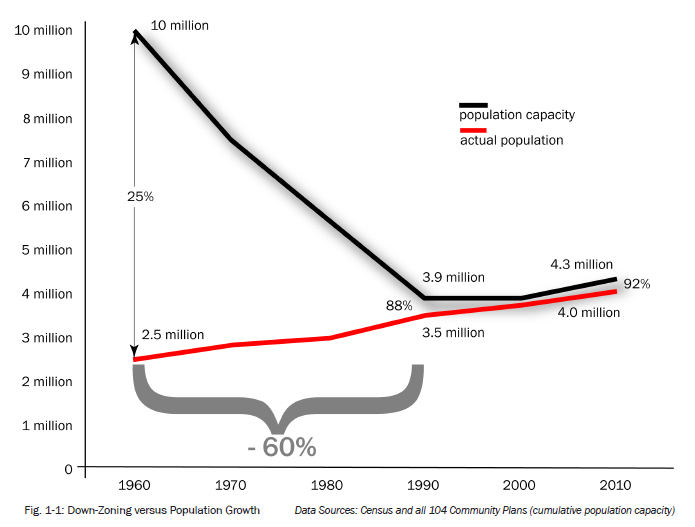Physical Address
304 North Cardinal St.
Dorchester Center, MA 02124
Physical Address
304 North Cardinal St.
Dorchester Center, MA 02124


In 1986, a foreshadowing of today’s fight over “neighborhood integrity” was taking place, culminating in November as Los Angeles residents voted 2-to-1 to cut the development potential of thousands of parcels across the city. Of the 29,000 acres zoned for commercial and industrial uses throughout LA, 70 percent saw their development capacity sliced in half, from a floor-area ratio (FAR) of 3.0 to 1.5. Since the city allows housing to be built in many of these zones, it didn’t just mean less office, retail, and manufacturing space, but fewer homes as well.
The ballot initiative responsible for these changes was called Proposition U, and it’s the reason that so many commercial corridors in LA are still characterized by 1960s and ’70s-era, single-story, dilapidated strip malls. All those arterial corridors were the ones permanently frozen in time by Prop U.
To my knowledge no one has ever assessed exactly how much this instance of “planning by the ballot” actually reduced the residential capacity of Los Angeles. By my very, very rough estimate, I would put the number somewhere on the order of 1 million homes.* But whether the actual number is 1 million, 500K, or over 2 million, the conclusion is the same: If we want to keep Los Angeles affordable for residents at all income levels, we should repeal Proposition U.
Repealing Proposition U would achieve several important aims. Since we’re talking about arterial, commercial corridors, the repeal would dramatically increase the supply of transit-oriented housing over the next several decades—something we desperately need at a time of record-low residential vacancy rates if we’re to have any hope of limiting continued rent increases. It would reduce development pressures on existing communities, directing development to underutilized corridors with little to no housing on them, rather than funneling developers into single-family neighborhoods to build mansions and small lot projects. And it would generate massive amounts of value that could be used to fund affordable housing, permanent supportive housing and other resources for the homeless, improved transit and transportation infrastructure, parks—you name it.
Repealing Prop U would directly address the two biggest challenges facing Los Angeles when it comes to preserving affordability. First, it would provide us an avenue (many Avenues, actually) to address our housing shortage. If we can’t build enough market-rate housing, nothing else matters. Second, it would fund the construction of tens, perhaps even hundreds of thousands of affordable homes for low income and homeless households, all at no cost to the city.

*Methodology: I came to the estimate of 1 million homes starting with the 29,000 acres figure. With 70 percent of this land affected by Prop U, the amount of land affected was around 20,000 acres, or 871 million square feet. A FAR of 3.0 across all of these parcels would allow for about 2.6 billion square feet of development. Assuming that the average FAR for existing developments was 1.0—meaning that there was the equivalent of a single-story building built across the entire parcel, or a two-story building covering half of the parcel—at the time Prop U passed (which is generous), that’s a gap between what exists and what could be built at 3.0 FAR of about 1.75 billion FAR.
If we assume the average size of a new apartment or condo is 800 square feet (again, pretty generous), that’s enough development capacity to build about 2.2 million homes. Lots of those would never be built because some of the development capacity might be used for retail or office space, schools, parking garages, open space, etc. Some parcels also just might not be great locations for development, whether because of the parcel itself or the neighborhood its located in. Or maybe the owner just wants to keep it as it is. For the sake of being very conservative in my assumptions, and because round numbers are nice, I cut that 2.2 million by 60 percent to arrive at my rough 1 million homes number.
[This post originally appeared on the blog Better Institutions]
yea!
Totally agree! Where do I sign up?!